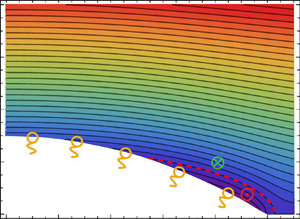Article contents
Shear flow over a surface containing a groove covered by an incompressible surfactant phase
Published online by Cambridge University Press: 30 September 2022
Abstract

We study shear-driven liquid flow over a planar surface with an embedded gas-filled groove, with the gas–liquid interface protruding slightly above or below the planar surface. The flow direction is along the groove, which is taken to be much longer than it is wide, and the gas–liquid interface is assumed to be covered by an incompressible surface fluid, representing a surfactant phase. Using the incompressibility condition for the surface fluid, the equations of motion and corresponding boundary conditions for the liquid phase are obtained by minimizing the dissipation rate. Assuming a moderate deformation of the interface, a domain perturbation technique with the maximal deformation as the small parameter is employed. The Stokes equation in the liquid phase under corresponding boundary conditions is solved to second order in the deformation using the Keldysh–Sedov formalism. The obtained analytical results are compared with numerical calculations of the same problem, allowing an assessment of the limits of validity of the expansion. While on a planar gas–liquid interface no flow is induced, a recirculating flow is observed on an interface protruding slightly above or below the planar surface. The study sheds light onto the mobility of curved gas–liquid interfaces in the presence of surfactants acting as an incompressible surface fluid.
JFM classification
Information
- Type
- JFM Papers
- Information
- Copyright
- © The Author(s), 2022. Published by Cambridge University Press
References
REFERENCES
- 8
- Cited by


